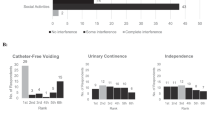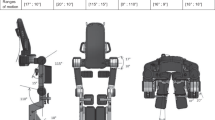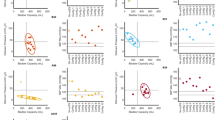Abstract
Study design:
Postintervention.
Objectives:
To determine the effectiveness of the Praxis multifunctional implantable functional electrical stimulation (FES) system (Neopraxis Pty. Ltd, Lane Cove, NSW, Australia) to provide standing and stepping ability and bladder and bowel management for individuals with motor complete thoracic level spinal cord injuries (SCI).
Setting:
Pediatric orthopedic hospital specializing in SCI.
Subjects:
Three males, ages 17 and 21 years, with motor-complete thoracic level SCI and intact lower motor neurons to the muscles targeted for stimulation.
Methods:
Each subject was successfully implanted with the Praxis FES system. All three subjects received electrodes for upright mobility and the first two subjects received additional electrodes for stimulated bladder and bowel management. Following training, subjects were evaluated in their ability to use FES for nine mobility activities. Acute and chronic experiments of the effect of stimulation on bowel and bladder function were also performed.
Results:
All three subjects could independently stand up from the wheelchair and could walk at least 6 m using a swing through gait pattern. Two subjects were able to independently perform swing through gait for 6 min and one subject was able to independently ascend and descend stairs. Suppression of reflex bladder contractions by neuromodulation (subject 1) and stimulated contractions of the rectum (subject 2) were observed in acute experiments. When stimulation was applied over the course of several weeks, a positive effect on bowel function was measured. Stimulated bladder contractions were not achieved.
Conclusion:
The feasibility of using the Praxis FES system for upright mobility and aiding aspects of bladder and bowel function was demonstrated with three subjects with thoracic level SCI.
Sponsorship:
This study was funded by Shriners Hospitals for Children Grant #8530.
Similar content being viewed by others
Log in or create a free account to read this content
Gain free access to this article, as well as selected content from this journal and more on nature.com
or
References
Davis R, Houdayer T, Andrews B, Barriskill A . Paraplegia: prolonged standing using closed-loop functional electrical stimulation and Andrews ankle-foot orthosis. Artif Organs 1999; 23: 418–420.
Davis R, Patrick J, Barriskill A . Development of functional electrical stimulators utilizing cochlear implant technology. Med Eng Phys 2001; 23: 61–68.
Kagaya H et al. Restoration and analysis of standing-up in complete paraplegia utilizing functional electrical stimulation. Arch Phys Med Rehabil 1995; 76: 876–881.
Kobetic R, Marsolais EB . Synthesis of paraplegic gait with multichannel functional neuromuscular stimulation. IEEE Trans Rehabil Eng 1994; 2: 66–79.
Johnston TE, Betz RR, Smith BT, Mulcahey MJ . Implanted functional electrical stimulation: an alternative for standing and walking in pediatric spinal cord injury. Spinal Cord 2003; 41: 144–152.
Nandurkar S, Marsolais EB, Kobetic R . Percutaneous implantation of iliopsoas for functional neuromuscular stimulation. Clin Orthop 2001; 389: 210–217.
Jones LM, Goulding A, Gerrard DF . DEXA: a practical and accurate tool to demonstrate total and regional bone loss, lean tissue loss and fat mass gain in paraplegia. Spinal Cord 1998; 36: 637–640.
Szollar SM, Martin EM, Parthemore JG, Sartoris DJ, Deftos LJ . Demineralization in tetraplegic and paraplegic man over time. Spinal Cord 1997; 35: 223–228.
Szollar SM, Martin EM, Parthemore JG, Sartoris DJ, Deftos LJ . Densitometric patterns of spinal cord injury associated bone loss. Spinal Cord 1997; 35: 374–382.
Szollar SM, Martin EM, Sartoris DJ, Parthemore JG, Deftos LJ . Bone mineral density and indexes of bone metabolism in spinal cord injury. Am J Phys Med Rehabil Med 1998; 77: 28–35.
Betz R, Boden B, Triolo R, Mesgarzadeh M, Gardner E, Fife R . Effects of functional electrical stimulation on the joints of adolescents with spinal cord injury. Paraplegia 1996; 34: 127–136.
Agarwal S, Kobetic R, Nandurkar S, Marsolais EB . Functional electrical stimulation for walking in paraplegia: 17-year follow-up of 2 cases. J Spinal Cord Med 2003; 26: 86–91.
Uhlir JP, Triolo RJ, Davis Jr JA, Bieri C . Performance of epimysial stimulating electrodes in the lower extremities of individuals with spinal cord injury. IEEE Trans Neural Syst Rehabil Eng 2004; 12: 279–287.
Kirkham AP, Knight SL, Craggs MD, Casey AT, Shah PJ . Neuromodulation through sacral nerve roots 2 to 4 with a Finetech–Brindley sacral posterior and anterior root stimulator. Spinal Cord 2002; 40: 272–281.
Kirkham AP, Shah NC, Knight SL, Shah PJ, Craggs MD . The acute effects of continuous and conditional neuromodulation on the bladder in spinal cord injury. Spinal Cord 2001; 39: 420–428.
Previnaire JG, Soler JM, Perrigot M . Is there a place for pudendal nerve maximal electrical stimulation for the treatment of detrusor hyperreflexia in spinal cord injury patients? Spinal Cord 1998; 36: 100–103.
Boyer S, Sawan M, Abdel-Gawad M, Robin S, Elhilali MM . Implantable selective stimulator to improve bladder voiding: design and chronic experiments in dogs. IEEE Trans Neural Sys Rehabil Eng 2000; 8: 464–470.
Bhadra N, Grunewald V, Creasey G, Mortimer JT . Selective suppression of sphincter activation during sacral anterior nerve root stimulation. Neurourol Urodyn 2002; 21: 55–64.
Binnie NR, Smith AN, Creasey GH, Edmond P . Constipation associated with chronic spinal cord injury: the effect of pelvic parasympathetic stimulation by the Brindley stimulator. Paraplegia 1991; 29: 463–469.
Creasey GH et al. An implantable neuroprosthesis for restoring bladder and bowel control to patients with spinal cord injuries: a multicenter trial. Arch Phys Med Rehabil 2001; 82: 1512–1519.
Triolo RJ, Bevelheimer T, Eisenhower G, Wormser D . Inter-rater reliability of a clinical test of standing function. J Spinal Cord Med 1995; 18: 14–22.
Author information
Authors and Affiliations
Rights and permissions
About this article
Cite this article
Johnston, T., Betz, R., Smith, B. et al. Implantable FES system for upright mobility and bladder and bowel function for individuals with spinal cord injury. Spinal Cord 43, 713–723 (2005). https://doi.org/10.1038/sj.sc.3101797
Published:
Issue date:
DOI: https://doi.org/10.1038/sj.sc.3101797
Keywords
This article is cited by
-
Comparative Efficacy of Transcutaneous Functional Electrical Stimulation With or Without Biofeedback Therapy on Functional Non-retentive Fecal Incontinence in Children: A Randomized Clinical Trial
Digestive Diseases and Sciences (2022)
-
A charge balancing technique for neurostimulators
Analog Integrated Circuits and Signal Processing (2020)
-
Traditional Biofeedback vs. Pelvic Floor Physical Therapy—Is One Clearly Superior?
Current Urology Reports (2019)
-
Implanted functional electrical stimulation: case report of a paraplegic patient with complete SCI after 9 years
Journal of NeuroEngineering and Rehabilitation (2014)



